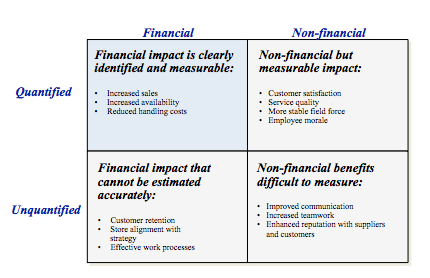“I’ve been having trouble getting approval for important changes to the way we do business. I can’t seem to get the leadership team on the same page. What can I do?”
#10 Business Case
What is a Business Case?
A Business Case describes the goal, costs and benefits of making a change with the purpose of influencing decision makers to approve the change. Although Business Cases are usually expressed in financial terms and written with the Chief Financial Officer (CFO) in mind, a strong business case is one that addresses not only the financial rationale for a change, but also the non-financial and non-quantifiable components of the change. The ability to tell a compelling story about the rationale for the change can be used both to gain approval for the change, and also to motivate people to implement the change.
A strong Business Case will include the goal/purpose, the benefits, costs, payback timeframe, measures and targets and risks and plans to mitigate them.
A business reason for any change is always required. But the level of proof required to make a decision will differ depending on the degree of money, time and risk involved. Regardless of the size or scope of the change, the sponsor or owner of the proposed change should always be able to articulate the rationale to all key stakeholders in a manner that creates enough dissonance between the ‘as is’ and the ‘to be’ to motivate support and action.
When to Use a Business Case
- When the desired decision is considered large, expensive or difficult to implement
- When a level of persuasion is required to gain leadership approval
- When the benefits of a decision are not clear to all involved in making the decision
How to use a Business Case
Preparing the Business Case
- Determine the owner/sponsor of the proposed decision and its business case. If you are not that person, work closely with the owner/sponsor every step of the way. Determine who else to include in the development of the business case and hold a meeting to design it together.
- Determine the key stakeholders, i.e. who will be involved in making the decision and implementing it. Think in advance how to address their concerns and motivations. The CFO will have different issues than the Human Resources Director, Sales Director, or Head of Customer Service. Gain insight into the drivers of executive decisions and align your Business Case accordingly.
- Be clear on the vision or goal of the decision. Be able to describe the future state once the change is made in a compelling way to all stakeholders. Also be able to describe the ‘do nothing’ status quo scenario and the risks of doing nothing.
- Define the financial and non-financial benefits, both quantifiable and unquantifiable. Below is an example.
- Outline the costs to get the benefits.
- Describe the payback timeframe and overall financial impact. Provide measures of success, along with targets and timeframes for achieving them.
- Describe risk areas, possible impacts and how to manage these risks.
- Consider overlapping initiatives, and how to handle them.
Gaining Agreement on your Business Case
- Be sure to validate your Business Case before presenting it. Test your case by arguing the other side.
- Pre-present your Business Case to key stakeholders and gain feedback and alignment. Tell a compelling story. Gain personal credibility with key decision makers. Make it real.
- Never assume support. Gain sign-off in writing from key decision makers.
Implementing your Business Case
- Refer back to your Business Case before, during and after implementation to ensure that it is met as per your original promise.
- If there are positive or negative changes, communicate them proactively to key stakeholders and decision makers.
- Course correct as necessary.
In Summary:
A Business Case describes the goal, costs and benefits of making a change with the purpose of influencing decision makers to approve the change.
Preparing your Business Case
- Determine the owner/sponsor of the proposed decision and its Business Case. Determine who else to include in the development of the Business Case and hold a meeting to design it together.
- Determine the key stakeholders, i.e. who will be involved in making the decision and implementing it.
- Be clear on the vision or goal of the decision.
- Define the financial and non-financial benefits, both quantifiable and unquantifiable.
- Outline the costs to get the benefits.
- Describe the payback timeframe and overall financial impact.
- Describe risk areas, possible impacts and how to manage these risks.
- Consider overlapping initiatives, and how to handle them.
Gaining Agreement on your Business Case
- Be sure to validate your Business Case before presenting it.
- Pre-present your Business Case to key stakeholders and gain feedback and alignment.
- Gain sign-off in writing from key decision makers.
Implementing your Business Case
- Refer back to your Business Case before, during and after implementation.
- If there are positive or negative changes, communicate them proactively.
- Course correct as necessary.
———————-
NOTE: If you would like to receive e-mail notification when I post additional techniques, please sign up through this link. http://eepurl.com/KILan You may unsubscribe at any time.
You will find my book Mission Critical Meetings: 81 Practical Facilitation Techniques on Amazon.
